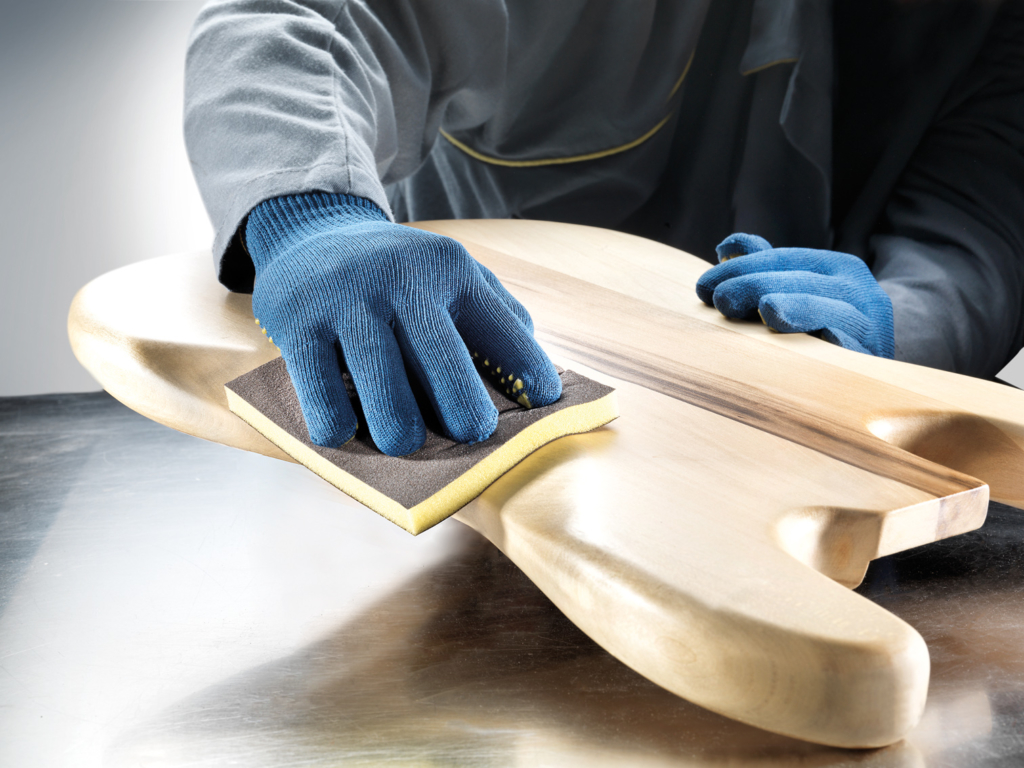Hand sanding – love or hate it, these tips will help you work better and faster

Hand sanding is a divisive topic among woodworkers. Some consider it to be an essential and satisfying process, others an interruption to their workflow, and everyone seems to have their own opinions on the best way to get the job done.
Wherever you stand on hand sanding, here are some observations and suggestions about this venerable element of our shared craft.
Hand sanding…why?
Even if you find sanding by hand laborious, you’ll have to concede that it can deliver a better finish than using power tools. A power sander can leave scratches, and can’t always manage the kind of fine-tuning around knots or fine mouldings which come naturally to practitioners of hand sanding. Indeed, in some specialised areas of woodworking – high-end luthiery, for instance – power sanding is normally either avoided completely or used only for roughing out a job.
If you’ve decided to give hand finishing a go, we think you’ll get some mileage out of the following tips.
1. Go with the grain
The first rule of hand sanding should be hung on the wall of every woodworker – go with the grain! Wisdom of this kind comes naturally to handworkers but tends to get lost in the hurly-burly of a powered woodworking shop. Sanding with the grain helps minimise torn wood fibres and gets your surfaces smoother, faster.
2. Getting gritty
In any sanding operation, you should look to do the minimum amount that gets the results you want. If you over-sand, you’re wasting time, wood and abrasives.
In practice, that means starting off the job with paper that’s just coarse enough remove the worst defects. You’ll likely choose an 80 grit to deal with the toothmarks in a sawn table leg, but a 100 to smooth down the matching planed tabletop.
Whatever grit you start with it, you’ll go on to re-sand with progressively higher grits to work out all the scratches. In practice, you’ll usually go 80>120>240 or 100>150>240. But if you start working with ultra-dense hardwoods like ebony, you may find yourself giving pieces an extra, final going-over with 320 or 400-grit paper. We stock a wide range of Sia sandpapers so, whatever grit you need, we can help.
3. No clogs
Anyone who’s ever hand-sanded a pine tabletop or taken a coat of paint off an heirloom piece will be familiar with clogging. However, surprisingly few of you opt for non-clogging papers. You don’t have to use a stearate-coated paper or an open web paper all the time, but having a stock is a must for every workshop.
4. Does your hand need a hand?
Sanding blocks are a help in any hand-sanding operation – but, for flat surfaces, they’re an absolute must. We stock the Sia range, and we know that these products will help you work faster, more efficiently and with better consistency. What’s not to like?
Well, sanding blocks do come with a downside, which is that makers who use them seem to go through abrasives faster. We think this is because blocks spread the load, so that the paper clogs across the whole surface rather than just under your fingertips. Anyway, a fresh sheet of sandpaper is a justifiable piece of indulgence!
5. Getting into the crevices
Contour sanding is a must for anyone working with decorative routing, but no-one has yet built a home-use power sander capable of handling the profiles created by routing or spindle moulding.
If you’re dealing with occasional routs and want to save your fingers, try contour sanding grips. These are neat shapes of grippable rubber. Choose one that fits the profile you’re sanding, wrap it with abrasive, and sand away with no damage to your fingertips. Result!
If you’re dealing with complex mouldings on a regular basis, you’ll find that you can save time by working with a rigid foam block. Use spraymount to attach a small sheet of sandpaper to the moulding – grit side up – making sure that it conforms exactly to the contour. Carefully run a rigid foam block over the abrasive until it takes on the profile of the moulding. Lastly, spraymount your chosen abrasive to the foam block. Now you have your own dedicated hand-sanding tool!
To discuss your abrasive requirements, give us a call on 023 9223 3310 or email us at sales@redwoodinnovations.co.uk.
